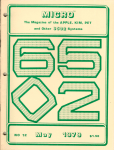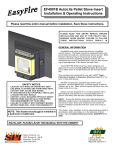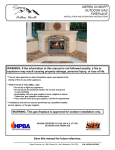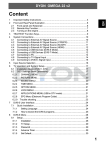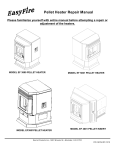Download Sierra Shenandoah R65-E Operating instructions
Transcript
Shenandoah R65-E Wood & Coal Burning Heater Manual (EPA Exempt) Installation & Operating Instructions Please read this entire manual before installation. Save these instructions. GENERAL INFORMATION C o n g ra tu lation s on yo u r p u rc h a s e of th e Sierra/Shenandoah Heater. W e are confident that your new stove will provide you with years of safe, com fortable and efficient heating. This m anual describes the installation and operation of the Shenandoah R-65E coal heater. Please read this entire m anual before you install and use your new room heater. Failure to follow instructions m ay result in property dam age, bodily injury, or even death. Save these instructions for future reference. SAFETY NOTICE If this appliance is not properly installed, a house fire m ay result. For your safety, follow the installation instructions. Check with local building or fire officials about restrictions and installation inspection requirem ents in your area. It is best to have a professional install your Sierra Stove. If you prefer to install it yourself (see Installation Instructions), be sure to obtain the proper perm its. Have the local building officials inspect the stove and chim ney pipe for safety and code com pliance after the installation is com plete. < < < < SAFETY NOTICE CAUTION: HOT W HILE IN OPERATION. KEEP CHILDREN, CLOTHING AND FURNITURE AW AY. CONTACT M AY CAUSE SKIN BURNS. IF THIS HEATER IS NOT PROPERLY INSTALLED, A HOUSE FIRE M AY RESULT. CONTACT LOCAL BUILDING OFFICIALS ABOUT RESTRICTIONS AND INSTALLATION INSPECTION REQUIREM ENTS IN YOUR AREA. FAILURE TO COM PLY W ITH OW NERS' M ANUAL INSTRUCTIONS W ILL VOID YOUR W ARRANTY! FAILURE TO FOLLOW INSTRUCTIONS M AY RESULT IN PROPERTY DAM AGE, BODILY INJURY, NOT APPROVED FOR M OBILE HOM ES. DO NOT USE CHEM ICALS OR FLUIDS TO START THE FIRE! DO NOT BURN GARBAGE OR FLAM M ABLE FLUIDS. DO NOT CONNECT TO ANY AIR DISTRIBUTION DUCT OR SYSTEM DO NOT CONNECT THIS APPLIANCE TO A CHIM NEY FLUE SERVING ANOTHER APPLIANCE. ALL SHENANDOAH SOLID FUEL ROOM HEATERS HAVE BEEN TESTED IN ACCORDANCE W ITH U.L.TEST STANDARD 1482-1998 TEST STANDARD PLEASE LEAVE THIS MANUAL WITH THE OWNER !! Listed by Warnock Hersey INSTALLATION INSTRUCTIONS • Installing a w ood or coral heater is different than other fuel burning appliances. 2. IF APPROVED FLOOR PROTECTION IS NOT USED: Use the follow ing calculation to determine if a proposed alternate floor protector meets the requirements listed in the appliance manual. • Failure to install correctly could result in a serious fire with loss of life and property. a. These instructions are to be used in conjunction w ith the fire codes and ordinances for your specific area which can be obtained from your local building inspector for Fire M arshall. If required, the proper perm it m ust be obtained! To protect your family and property, you should determine the applicable codes and ordinances and strictly adhere to them. Convert specification to R-value. i. R-value is given – no conversion is needed. ii. K-factor is given with a required thickness (T) in inches: R = 1/k x T iii. C-factor is given: r = 1/C b. Determine the R-value of the proposed alternate floor protector. i. Use the formula in step (a) to convert values not expressed as ”R”. ii. For multiple layers, add R-values of each layer to determine the overall R value. A proper draft is absolutely essential to achieve satisfactory performance. c. If the overall R-value of the system is greater than the R-value of the specified floor protector, the alternate is acceptable.. • Too little draft will cause poor burning and smoking. Example: The specified floor protector should be ¾ inch thick material with a K-factor of 0.84. The proposed alternate is 4” brick with a C-factor of 1.25 over 1/8” mineral board with a K-factor of 0.29. • Too high a draft will cause the unit to burn too hot and use excessive fuel. • The draft reading should be from .04 to .07 inches of w ater column (.06 W .C. is the desired draft). It is the responsibility of the user to obtain the proper draft range. Step (a.) Use the formula above to convert specification to R-value. R = 1/k x T = 1/0.84 x .75 = 0.893 Step (b.) Calculate R of proposed system 4” brick of C= 1.25, therefore R brick = 1/C = 1/1.25 = 0.80 1/8”mineral board of k=0.29, therefore R min.bd = 1/0.29 x0.125 = 0.431 Total R = Rbrick + Rmineral board = 0.8 + 0.431 = 1.231 Step (c.) Compare proposed system R of 1.231 to specified R of 0.893. Since proposed system R is greater than required, the system is acceptable. • Low draft conditions may be corrected by using a larger flue pipe, shorter connector pipe, or extending the chimney height. • High draft conditions may be corrected by installing a barometric damper. • A qualified serviceman should be consulted of correction of chimney draft. A. CHOOSING A LOCATION A central location is most desirable, how ever, the minimum required run of pipe to the chimney should be the deciding factor. Definitions: Thermal Conductance = C = Shenandoah Heaters must use an approved system for venting flue gases. Figures 2 - 5 indicate various methods. Btu = (hr)(ft 2)( BF) Thermal Conductance = k = Btu = W = (hr)(ft 2)( BF) (m 2)( BK) B. PRIOR TO INSTALLATION W (m 2)( BK) Btu (hr)(ft)( BF) 1. Remove carton, crating and all packing material from the heater. Thermal Conductance = R = (ft 2)(hr)( BF) = (m 2)( BK) Btu W 2. Fire the stove outdoors to cure the paint, and burn off odor of oils and solvents used in manufacturing. Could cause unpleasant odors in the home. 3. 4. Keep combustibles at least three feet from the heater. This includes furniture, magazine racks, rugs, clothing and firew ood. C. CLEARANCE FOR SHEANDOAH HEATERS (Floor Protector) 1. Do not install in closets or alcoves. Do not dry clothes on or within three feet of the heater, or store flammable liquids in the same room as the heater. SET THE HEATER ON A NON-COM BUSTIBLE FLOOR PROTECTOR W ITH AN R-VALVE OF 1.0 OR LISTED FLOOR PROTECTION that covers an area 8” larger than the heater on three sides and extends 16” beyond the ash and loading doors and under the chimney connector 2” beyond each side. M inimum clearances from combustible materials w ithout protection: M odel R65 ( See figure 1) Sides Back Fuel Door A B 32" 26" 36" 2 Top 48" Connector Pipe 18" 5. M inimum clearances from combustible materials w ith protection: D. Connector Pipe Installation This connector pipe connects the heater to the chimney. The distances betw een the sides and/or back can be reduced by placing an approved wall protection panel over the combustible walls. Consult NFPA 211 for reduced clearances allowed a proper installation. On Shenandoah heaters, this pipe should be at least 6 inches in diameter, 24 gauge, or heavier, black pipe. It is recommended that connector pipes be installed with the crimped end down, including the section which goes into the heater collar. In this w ay, any possible creosote form ation will drain dow n the inside pipe. (The R65-E comes equipped with a cast iron damper in the flue collar. You may need to cut slots in your stove pipe to fit over the damper rod.) IM PORTANT: ALL PIPE JOINTS AND THE CONNECTION TO THE HEATER COLLAR SHOULD BE SECURED W ITH AT LEAST THREE M ETAL SCREW S. The connector pipe should be at least 18 inches or more from combustible materials. The connector pipe should be as straight and short as possible (keeping minimum clearances in mind). It should have no more than tw o 90 degree elbow s. The horizontal connectors are required by NFPA (National Fire Protection Association) No.211 to have at least ¼ inch rise to the linear foot. It should be easily accessible for cleaning, and should not pass through walls, floors or ceiling w ithout being properly insulated for heat. The connector pipe should not be installed outside or through unheated inside areas because condensation of hot gasses com ing in contact w ith a cold pipe w ill cause rapid creosote accumulations. CHIM NEY CONNECTOR SYSTEM S AND CLEARANCES FROM COM BUSTIBLE W ALLS FOR RESIDENTIAL HEATING APPLIANCES Figure 1 A. M inimum 3.5 inch thick brick masonry all framed into combustible wall with a minimum of 12 inch brick separation from clay liner to combustibles. The fireclay liner shall run from outer surface of brick to wall, but not beyond the inner surface of the chimney flue liner and shall be firmly cemented in place. Figure 2 Figure 3 3 E. Proper Draft The chimney draft greatly influences the operation. Too little draft can cause smoke to puff from the thermostat damper or from the door. To increase draft: use a larger flue pipe, shorten connector pipe or extend chimney height. Too much draft could cause overheating. A barom etric damper installed in the connector pipe close to the heater can control excessive draft. The flue area of the chimney should be a minimum area equivalent to 6 inch diameter flue pipe. If necessary, the draft can be checked by qualified serviceman and should have a draft of .04 inches of water colum n m inim um and .07 m aximum. B. Solid insulated, listed factory-built chimney length of the same inside diameter as the chimney connector and having 1 inch or more of insulation w ith a minimum 9 inches air space betw een the outer wall of the chimney length and combustibles. Chimney Draft 1. Factory Build Chimneys: M ust be listed type HT per UL 103. NFPA No.211 requires factory built chimneys to be listed and installed in accordance w ith conditions of the listing and the manufacturer’s instructions. NFPA No.211 also requires the chimney to extend at least 3 feet above the highest point where it passes through the roof, and at least 2 feet higher than any portion of a building within 10 feet of the pipe. (See figures 2 & 3) 2. Brick Chimney with Thimble: When an existing chimney is used be sure it is in good repair and has a suitable chimney flue liner. A solid fuel heater should not be connected to the same chimney as other heating appliances. Unsatisfactory performance can result from variable or insufficient draft. C. Sheet steel chimney connector, minimum 24 gauge in thickness with a ventilated thimble, minimum 24 gauge in thickness, having tw o 1 inch air channels, separated from combustibles by a minimum of 6 inches of glass fiber insulation. Opening shall be covered, and thimble support with a sheet steel support, minimum 24 gauge in thickness. D. Solid insulated, listed, factory-built chimney length, with an inside diameter 2 inch larger than the chimney connector, and having 1 inch or more of insulation. Serving as a pass-through for a single wall sheet steel chimney connector of minimum 24 gauge thickness, w ith a m inim um 2 inch air space betw een the outer wall of the chimney section and combustibles. M inimum length of a chimney section shall be 12 inches chimney section spaced 1inch aw ay from connector using sheet steel support plates on both ends of chimney section. Opening shall be covered, an chimney section supported on both sides with sheet steel support securely fastened to w all surface of minimum 24 gauge thickness. Fasteners used to secure chimney section shall not penetrate chimney flue liner. A connector to masonry chimney shall extend through the inner face or liner but not beyond, and shall be firmly cemented to masonry chimney. A thimble may be used to facilitate removal of the chimney connector for cleaning, in which case the thimble shall be permanently cemented in place w ith high temperature cement (see figure 4). Figure 4 4 3. Brick Chimney w ith Fireplace: The heater can be vented into the fireplace by sealing the opening w ith noncombustible material and material and extending the connector pipe into the chimney dam per. Refer to your local codes (see Figure 5). B. Starting the Fire and Burning Techniques Warning: Do not use gasoline, gasoline type lantern fuel, kerosene, Charcoal lighter fluid or similar liquids to start or ‘freshen up’ a fire in this heater. Keep all such liquids well away from the heater. DO NOT BURN garbage, gasoline, naphtha, engine oil or any flammable liquids or chemicals or burn you stove without grates in place. DO NOT IN ANYW AY CAUSE THE UNIT TO OVER-FIRE BY OVERRIDING THE THERM OSTAT CONTROL. This is an unsafe operation of the unit and could severely damage the unit as well as endanger your home. For this reason, this type of operation w ould invalidate the w arranty. Burning W ood To start a wood fire, place crumpled new spaper on the grate and cover it with kindling wood in a criss cross pattern. Then place larger sticks on top of the kindling. Before lighting the paper, be sure the thermostat control is on “HIGH” and the flue damper is open. After lighting, close the door and latch. Place additional wood in the heater as desired after a fire bed is established and adjust the dam per. Adjust the thermostat from time to time until the desired comfort is obtained. The bi-metal therm ostat w ill automatically control the combustion air to the fire thus m aintaining the desired heat output. Burning W ood on a coal grate Because this unit will burn either w ood or coal, a cast iron grate has been use. In order for w ood to burn efficiently an ash build-up of 1" to 2" should be allowed to accumulate on the grate. This tends to plug the holes and reduce air flow to the wood so it doesn’t burn too quickly. Therefore, do not shake the ashes dow n through the grate until the build-up has occurred. The ashes also serve to insulate the grate from the hot coals thus extending the life of the grate. Figure 5 Bi-metal Thermostat Control Shenandoah Heaters are therm ostatically controlled, but do need reasonable attention to assure efficient and trouble free operation, The thermostat controls the dam per providing an increase or decrease in combustion air to the fire. Adjustm ent for comfort is necessary. Types of wood Split dry hardw oods (20% moisture levels) is recommended for the best perform ance. This will produce 5,500 to 6,000 BTU per pound. A mixture of green and dry wood will produce satisfactorily. W et and green wood will reduce the heat output of the unit because the BTUH output is reduced by the moisture content during the early stages of the burn. • Turn knob tow ard “HIGH” to increase heat output. • Turn knob tow ard “LOW ” to decrease heat output. A. Before building the first fire 1. 2. 3. Com bustible materials must be kept at least three feet from the stove. This includes furniture, magazine racks, rugs, clothing and firewood. Do not dry clothing or within three feet of the heater, or store flammable liquids in the same room with the heater. Burn tim e Depending on the type of wood (hard or soft) and the bi-metal thermostat setting, a variable burn time can be obtained. With a full firebox of hardw ood at low setting, an overnight (8 to 10 hours) burn can norm ally be obtained. Occasionally the movement and the handling of the unit affects the bi metal thermostat and dam per controls. Prior to building the firs fire, check the operation of the therm ostat damper. W ith a flashlight, shine light through the top of the thermostat cover and observe the dam per as the control knob is moved from low to high, the damper must move freely and have no hesitation in either the up or dow n movement. If hesitation or sticking occurs, have the thermostat corrected. Adding w ood to the fire box Check the grate operates to assure it is in position and operates properly. Do not burn the stove without the grates in place. 5 1. Open smoke outlet damper. FULL OPEN. 2. Open door slowly to allow air to move into the firebox without creating a turbulence 3. Check buildup under coals with poker, and if tight, loosen up and force some ash into the ash pan. This may also be done with the shaker grate before wood is added. 4. Place w ood on hot coals with small pieces at the bottom . 5. Close door and latch. though some ash is desired to help keep the grates cool, it is essential that ask is not allow ed to block the air passage. If this occurs the fire will cool dow n and may go out. If fire bed is small, move the thermostat knob to HIGH and fire will recover more quickly. Then adjust to lower setting. To sustain the fire bed, add fuel while the bed of coals is hot. For normal operation add coals tw ice per day, morning and evening. If fire bed is large and hot, no adjustment to the thermostat know is necessary. Adjust the smoke outlet damper after the fire has rekindled. Adding Coal A. Before building the first fire C. Coal Burning The techniques for burning coal are substantially different from that required to burn wood. The techniques likew ise vary for each installation and for different heater designs. Types of Coal There are tw o recommended types of coal: Bitum inous (soft coal), in either nut or stove size, and Anthracite (hard coal), in nut size. There are varying grades within each of these types depending on the quality of the coal mined. Ash yield is a factor to consider since low ash content (8% or less) is desired. As a result of varying qualities, specific burning characteristics cannot be provided. How ever, it is generally accepted soft coals have many of the same burning characteristics as wood, requiring similar air to fuel to ratios. Burning experience has been excellent w ith soft coals. Some soft coals have high sulfur content, and due to emission cannot be burned in all locations. 1. Open pipe damper. 2. Open door. 3. Check ash pan and remove ashes. 4. Replace ash pan. 5. Add 20-25 pounds of coal. 6. Bank coal to top of firebrick in the back, slightly heaping tow ard the center, then taper toward the door opening. 7. Leave some hot coals (6" square) exposed in front to burn off gasses. 8. Insert handle into grate and shake until hot coals to fall into ash pan. A glow will appear in the ash pan. 9. Do not over shake grate. 10. Remove handle, close and latch door. 11. M ove the thermostat knob to HIGH setting for approximately 15 minutes. The Anthracite (hard coal) is a cleaner burning product and yields an excellent fire. Experience indicates that more attention is required for hard coal fires and the temperature of the coal bed m ust be maintained to assure desired performance. 12. A blue flame should appear over the top of the fresh coal. 13. M ove thermostat to lower setting (to be determined by experience). Starting a Coal Fire 14. Close pipe damper. To start a coal fire, follow the same procedure for starting a wood fire. After the wood fire is burning, add several small shovels of coal over the fire. As the coal starts burn and glow, add more shovels in small quantities until a glow ing coal bed is established at a depth of 6 inch to 8 inches tapering from the back toward the door. DO NOT allow coal bed to go above fire brick lining. Depending on the size of the fire box, 20-35 lbs of coal should sustain the fire for approximately 12 hours. A fire can be maintained on a continuous basis if given the necessary attention. If fire bed cools too much betw een loadings, it may be necessary to place som e kindling on the fire bed prior to adding fresh coal to reduce the recovery time. After adding a large quantity of coal (15 lbs or more) and w ith pipe dam per open, allow the heater to operate on “HIGH” for approximately 15 minutes to ignite the fresh fuel. Immediately after fresh coal has been added, it is normal that the heat output will drop until the fire bed is re-established. A blue flame should appear over the surface of the coal bed. When this occurs, adjust the thermostat to a lower setting and close the pipe damper. Check fire periodically to assure that it is spreading throughout the fuel bed. Your stove has the cast iron outer grate with a round center shaker grate, it will be necessary to use a poker to work out ash from around the edge of the fire bed next to the firebrick or the coals will tend to go out. This can best be accomplished by turning the end of a “L” shaped poker vertical with the end pointing dow n. Insert along the side next to the firebrick and move from front to back. To remove ash from the area outside of the center grate, insert the end of the poker up through the grate from underneath the grate and w ork back and forth through slots. Burn Time (coal) A properly controlled coal fire can burn for extended lengths of time. Experience indicates that from ¾ pounds to 5 pounds per hour can be burned. In m ilder weather and w ith proper ash control, 24 hour burn can be obtained. The fire box can hold approximated 40 to 70 pounds of coal depending on the model. Remove ashes at least once a day while burning continuously. Never allow ashes to build up in grate. Sustaining the Coal Fire Burning Coal (Continued) The efficiency and heat output of a coal fire is directly affected by the air flow through the coal bed and ash accum ulation on the grate. Even Depending on the quality of coal used, it may be necessary to periodically remove all un-burnable 6 material and ashes from the heater and start a new fire. The fire should be allow ed to go out. 3. DO NOT attempt to remove hot live coals. 4. Each installation will vary slightly. Therefore, only w ith experience can the best firing procedure be determ ined. 5. Opening the Fill Door Chimney inspection and cleaning M aking sure smoke outlet damper is FULL OPEN, open the door ½ inch for 15 seconds before opening it completely. This provides a slow combustion of the accumulated gases above the fire rather that a sudden burst of flame caused by the introductions of oxygen. This will also allow sm oke to move out of the heater more completely. The chimney and heater should be inspected for creosote buildup every tw o weeks during the heating season. Creosote is recognizable as a black oily or flaky deposit on the walls of the heater and flue. If creosote has accumulated, it should be removed to reduce the risk of a chimney fire. D. Ash Control and Removal PERFORMANCE TIPS For best results, shake dow n ashes until live coals start to fall. Remove the ashes when the fir is low prior to adding fuel. This should be done daily or as often as required to avoid ash buildup. A. If your heater SM OKES, has LOW HEAT OUTPUT, or CANNOT M AINTAIN A FIRE, review the following: DO NOT allow ashes to build up to the grate level as this will cause intense heat on the grate and cause it to warp and have a short life. Inspect the area around the ash pan and clean out as required. 1. The chimney draft must be at least .04" W .C. w ith .06" W .C. the recommended draft. 2. Clean creosote deposits from the chimney and connector pipe. 3. The connector pipe from the heater to the chimney may be too long. Reposition the heater, if possible, for minimum clearances. 4. Do not have more than tw o 90 degree elbows in the connector pipe. 5. Horizontal connector pipe must have 1/4" rise per linear foot. 6. Use a chimney cap to reduce dow n drafts in the chimney. 7. M ore than one heating appliance connected to the sam e chimney flue can affect the draft. 8. Ash clean out at the chimney base must be sealed with the door closed tightly. 9. Rem ove tree limbs that are too close to chimney. 10. The chimney height may not be adequate for proper draft. Increase height if necessary. 11. Burn small hot fires instead of heavily loaded smoldering fires in mild weather. 12. Sufficient combustion air may not be available to the heater. This can occur in some new ly constructed highly insulated “light” houses. Open a window I the room in w hich the heater is located., If this helps, then outside air must be piped to the damper area of the heater. Consult your dealer for assistance. For disposal of ashes, places ashes in m etal container with a tight fitting lid. The closed container of ashes should be placed on an incombustible floor or on the ground, well away from all combustible materials, pending final disposal. If ashes are disposed of by burial in the soil or otherw ise locally dispersed, they should be retained in the closed container until all cinders have thoroughly cooled. DO NOT USE A PAPER BAG OR BOX. E. Creosote & Soot Formation and Removal W hen coal is burned, products of combustion combine with moisture to form a soot residue w hich accum ulates on the flue lining. W hen ignited, this soot makes an extremely hot fire. W hen wood is burned slowly, it produces tar and other organic vapors which com bine w ith expelled moisture to form creosote. The creosote vapors condense in the relatively cool chimney flue of a slow burning fire. As a result, creosote residue accumulates on the flue lining, the connector pipe and within the heater. W hen ignited, this creosote makes an extremely hot fire. B. Fire Burns Too Hot or Too Fast If this happens, the fire department should be called immediately. Extinguish the fire in the heater by dumping a large quantity of coarse salt on the fire, or by using a dry pow der to keep air from entering the chimney. If possible, do not use water to extinguish a chimney fire because it could dam age the flue liner. If there is a major creosote problem, have the chimney, stove pipe and heater cleaned and inspected before firing the heater again. 1. 2. 3. 4. 5. 6. 7. In addition to being a fire hazard, the presence of creosote will affect the performance by reducing the draft. This may cause smoking from the fill door or cause the inability to hold a fire. 8. Check door gasket for proper seal. Be sure knob is set to LOW setting. Check combustion air damper. Be sure it is not sticking open. (See section B under Operating instructions) For wood burning, allow ashes to build up on grate. Check chim ney draft - .07" W .C. maximum. High winds or prevailing winds may cause excessive draft. Install a barom etric damper in pipe to reduce drat. Contact dealer for assistance. C. Coal Fire Goes Out The chimney connector and chimney should be inspected at least once every tw o months during the heating season to determine if a soot buildup has occurred. To reduce Creosote Problem : 1. 2. Keep stack temperature above 250 degrees Fahrenheit. Below 250 degrees Fahrenheit produces black liquid creosote. Rather than burn the heater extensively at a low setting during the mild temperatures of 50 degrees and above, build a small hot fire for a short period of time. Install the heater with the connector pipes as short as possible. Use dry wood. Burn a hot fire for approximately 30 minutes daily. 7 1. Check chimney draft. Should be no less than .04" W .C. but .06" is recommended. 2. Shake dow n ashes more frequently. PERFORMANCE TIPS (continued) 3. stores. Care should be taken to avoid damaging the flue liner. Chimney cleaning service is available in most areas. Use poker with tip vertical and down to remove ashes from the edges of the grate next to the firebrick. 4. Remove the ashes. Do not allow them to build up under the grate in the ash pan. 5. Keep pipe damper open until fire has rekindled. 6. Check quality of coal being used. It must be good quality with low ash yield. 7. Adjust damper control knob for increased combustion air. 8. If wood has been burned previously, check chimney for creosote buildup. Clean as necessary. 9. Chimney cap may be too restrictive. D. Firebrick Inspection At least once a year, check the condition of the firebrick lining. All broken firebricks should be replaced. New firebrick can be obtained from your Shenandoah dealer. SERVICE TIPS (To be Performed Only by Qualified Installers) Re-calibrating Thermostat Control Note: All calibration is done at approximately 70 degrees Fahrenheit 11. Fire bed m ay be too shallow . Hot fir bed m ust be maintained at 6" depth or more. The heat output of the stove is controlled by the draft opening. This operates automatically by the bimetal thermostat opening and closing the damper plate. The normal temperature operating range is preset at the factory. 12. Periodically add wood kindling with the coal to reestablish the bed coal. It is rare, but possible, for the operating range to change after the heater is put into use. 10. M ay be using wrong size coal. Chestnut size is recommended. D. Heater M akes Noise M etal cools off and contracts when it gets hot and cools off. This may cause the heater to occasionally give off some thumping and banging noises. The noises should not be to a distractive level nor reoccur w hile the heater is hot. As wood burns, a log w ill often roll off the pile and strike the side or front of the stove. It will create a moderate thumping noise. E. Unit W arps or Bow s Slightly As metal expands under heat, it has to move. This w ill tend to increase as the fire gets hotter. As the heater cools off, the metal will return to near original conditions. It is not abnormal or in any way hazardous to have a minor change in m etal flatness after having been heated. The control should be re-calibrated for peak performance as follow s: MAINTENANCE INSTRUCTIONS 1. Long life and perform ance of the heater is directly related to proper maintenance. Please follow these suggestions. Turn control knob counter clockw ise until pointer is against stop pin. 2. Rem ove control knob from stem. A. Summer Storage 3. Turn stem until the damper plate is completely closed. 4. Turn stem clockw ise until dam per plate starts to open. 5. Replace know with the pointer directed to Second indicator mark past LOW (See Diagram above) If the heater is rem oved during the off-season, store it in a dry place to prevent rust. Before storing, remove the ashes, clean, and touch up the paint w here needed. A high temperature paint is available from your dealer. B. Yearly Flue Inspection Each year before putting the heater into service, the chimney flue should be cleaned of soot and other residues, and inspected for needed repairs or any accumulation of creosote. The inspection is in addition to the bimonthly inspections during the heating season. SERVICE TIPS (Continued) (To be Performed Only by Qualified Installers) A. Door Adjustm ents Occasionally it is desirable to improve its operation or the seal betw een the door and frame. This can result from minor changes due to normal metal expansion after being subjected to heat. C. Creosote Rem oval Creosote should be removed from the chimney using appropriate brushes and tools. These are available through many stove dealers and hardw are 8 By determining the type of adjustment desired, the follow ing procedure will make it simple and quick. 1. 4. If door is tight on hinge side thus causing the door to feel springy just prior to latch, If neither steps 2 or 3 adjusts as desired, loosen catch (2 bolts0 and position in or out as required (see figure below) To check for gasket seal, place a folded sheet of paper betw een the door and frame with the door shut. Pull paper to feel friction betw een the gasket and door frame. loosen hinge plates (2 bolts each) and allow to move outw ard slightly. Do not allow to move out far enough to lose the seal betw een the door fram e and gasket. 2. If Door latch opens and closes hard, tap door catch dow n slightly. 3. If door latch opens and closes too easily, tap door catch up slightly. By following the m anufacturer’s recom m endations your Sierra Stove will give you years of service. R65 Replacement Parts List P/N CONSUM ER PROTECTION W ARRANTY Your Sierra Stove has a Lim ited Five-Year W arranty. Please read it carefully, fill out the short registration form and return it, within 30 days of purchase, to Sierra Products, Inc., 5061 Brooks St. Ste. B Montclair, CA 91763. Should you have a warranty claim on your Sierra Stove, notify your nearest dealer, or contact Sierra Products, Inc. at the above address. For additional information www.sierraproductsinc.net Description 100045.1 Metallic Black Touch Up #3609 410079 Therm ostat Brass Rod R65/ 77 410080 Therm ostat Knob R65/77 410081 Flue Dam per R65/77 410082 Outer Grate Ring R65 410083 R65 Center Grate 410085 R65 Draw Bar/ Shaker 410086 Bi- Metal Therm o Spring R65/77 410088 Door Assem bly R65/77 410089 Door Gasket R65/77 410090 Door Handle Assy. R65/77 410096 Side Refractory Liner R65 Curved P/N 140818 R65E MANUAL r1 Sierra Products, Inc. 5061 Brooks St. Ste B M ontclair, CA 91763 9









